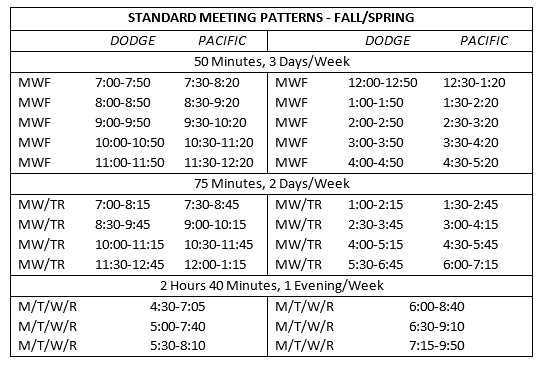Course Scheduling Guidelines
Effective Date- Spring 2023
Course scheduling allows the campus to maximize the chance for students to develop workable schedules in order to make progress on their academic journeys. Effective course scheduling can achieve better academic and institutional efficiencies.
- The schedule for each semester is automatically pre-populated with previous enrollment maximums (i.e., capacity). Future capacity should not typically be less than previous enrollment.
- It is reasonable to adjust capacity downward if there is evidence of decreased demand.
- Schedule graduate (8--- level especially, 9000 may have more flexibility) lecture courses with capacities of > 8
- Schedule undergraduate lecture courses with minimum capacities > 20
- The Dean’s Office and the scheduling units should be monitoring enrollments continually. The Course and Space Utilization Dashboard on the Analytics page is one place to monitor enrollments and can be accessed at https://www.unomaha.edu/analytics.
- Lecture courses should be cancelled, no later than 21 days prior to the start of an academic term, if they have enrolled <10 undergraduate students or < 5 graduate students. Exceptions to the aforementioned numbers require explicit approval from the Dean’s Office. This proactive measure will allow faculty sufficient notice to redirect their teaching preparation to a different course and will save in adjunct costs.
Standard Meeting Patterns
- In order to minimize class conflicts for students and maximize classroom utilization, classes must use standard times, listed below, unless approved by the Office of the University Registrar.

Non-Standard Meeting Patterns
- Departments must have approval of the Office of the University Registrar in order to schedule a class at a non-standard time.
- A class which meets longer than the standard meeting time must not cross more than two 75-minute standard class times. Example:
Allowable: Monday 8:30-11:10 crosses Monday/Wednesday 8:30-9:45 and 10:00-11:15
Not Allowed: Monday 9:00-11:40 crosses Monday/Wednesday 8:30-9:45, 10:00-11:15, and 11:30-12:45 - A class scheduled one day per week must be paired with another class of similar size on the opposite day of the week, unless it’s after 5:00 P.M. This allows full utilization of the classrooms.
Example: Monday 8:30-11:10 should be paired with Wednesday 8:30-11:10 -
- Classes will be allowed to meet four or five days per week if pedagogically necessary.
Level Scheduling Guidelines
Primetime Scheduling
- “Primetime” is defined as Monday through Thursday from 10:00am to 2:15 pm.
- No more than 50% of each departments sections can be scheduled during Primetime.
- If the department schedules 10 or fewer sections for the semester, they must have no more than 65% of their sections during Primetime.
Balanced Scheduling
- No more than 50% of each department’s sections can be scheduled on the following days:
Tue/Thu, Tuesday only, or Thursday only.
- At least 40% of each department’s sections must be scheduled on the following days:
Mon/Wed, Mon/Wed/Fri, Monday only, Wednesday only, or Friday only.
- For cross-listed or combined sections, the department “owning” the course (i.e. the department in which the Primary instructor belongs) counts it toward their percentages.
- “TBA” meeting patterns are only allowed on courses that are independent in nature, and have no need for a general purpose classroom.
Classroom Assignments
- Classes using standard meeting patterns will be given priority over those using non-standard meeting patterns.
- Classes are assigned to rooms based on seating capacity and maximum enrollment.
- Instructors teaching back-to-back sections will be given priority in order to schedule them in the same building or classroom.
- Room requests based on health reasons will be given priority.
- Room requests based on pedagogical reasons will be considered, but cannot be guaranteed.
- Non-standard classes that can fully utilize their given rooms may be given priority.
- Departments owning lecture classrooms will be given first priority in their rooms; open class times may be used for other departments.